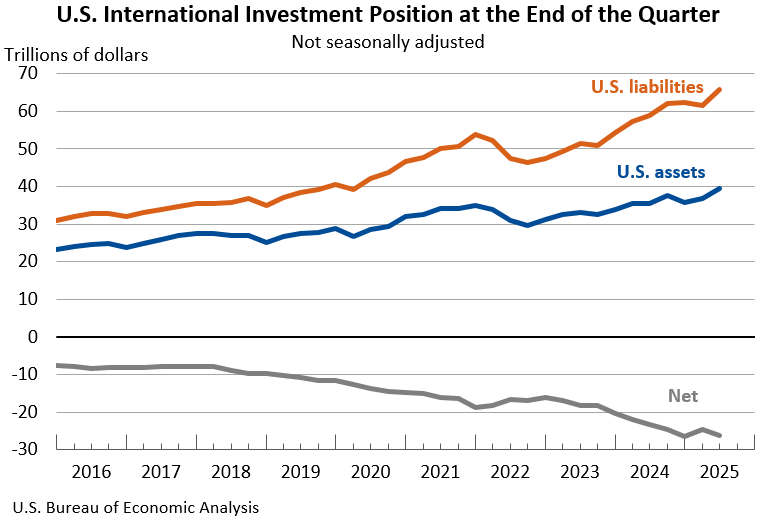Notice
Due to a lapse in appropriations, this website is not being updated.
Bureau of Economic Analysis
U.S. International Investment Position, 2nd Quarter 2025
The U.S. net international investment position, the difference between U.S. residents’ foreign financial assets and liabilities, was -$26.14 trillion at the end of the second quarter of 2025, according to statistics released today by the U.S. Bureau of Economic Analysis. Assets totaled $39.56 trillion, and liabilities were $65.71 trillion. At the end of the first quarter, the net investment position was -$24.65 trillion (revised).
Principal Federal Economic Indicators
Noteworthy
The Latest
U.S. International Trade in Goods and Services, September 2019
The U.S. monthly international trade deficit decreased in September 2019 according to the U.S. Bureau of Economic Analysis and the U.S. Census Bureau. The deficit decreased from $55.0 billion in August (revised) to $52.5 billion in September, as imports decreased more than exports. The previously published August deficit was $54.9 billion. The goods deficit decreased $2.7 billion in September to $71.7 billion. The services surplus decreased $0.1…
Real Disposable Personal Income Rises in September
Personal income increased 0.3 percent in September after increasing 0.5 percent in August. Wages and salaries, the largest component of personal income, showed no change in September after increasing 0.6 percent in August.
Personal Income and Outlays, September 2019
Personal income increased 0.3 percent in September after increasing 0.5 percent in August. Wages and salaries, the largest component of personal income, showed no change in September after increasing 0.6 percent in August.
GDP Increases in Third Quarter
Real gross domestic product (GDP) increased 1.9 percent in the third quarter of 2019, according to the “advance” estimate released by the Bureau of Economic Analysis. In the second quarter, real GDP increased 2.0 percent.
Gross Domestic Product, Third Quarter 2019 (Advance Estimate)
Real gross domestic product (GDP) increased 1.9 percent in the third quarter of 2019, according to the “advance” estimate released by the Bureau of Economic Analysis. In the second quarter, real GDP increased 2.0 percent.
Gross Domestic Product by Industry: Second Quarter 2019
Professional, scientific, and technical services; real estate and rental and leasing; and mining were the leading contributors to the increase in U.S. economic growth in the second quarter of 2019. The private goods‐ and services‐producing industries, as well as the government sector, contributed to the increase. Overall, 14 of 22 industry groups contributed to the 2.0 percent increase in real GDP in the second quarter.
Gross Domestic Product by Industry: Second Quarter 2019
Professional, scientific, and technical services; real estate and rental and leasing; and mining were the leading contributors to the increase in U.S. economic growth in the second quarter of 2019. The private goods‐ and services‐producing industries, as well as the government sector, contributed to the increase. Overall, 14 of 22 industry groups contributed to the 2.0 percent increase in real GDP in the second quarter.
Prototype Economic Statistics for Puerto Rico, 2012-2017
The Bureau of Economic Analysis (BEA) released for the first time prototype statistics for consumer spending, business investment, and trade in goods for Puerto Rico. These new economic data lay the groundwork for BEA to estimate the island's GDP. Currently, the annual statistics cover the time period from 2012 to 2017 and can be used to better gauge the performance of the Puerto Rico economy over that period.
Prototype Economic Statistics for Puerto Rico Now Available
Today, the Bureau of Economic Analysis released prototype statistics for personal consumption expenditures, private fixed investment, and net exports of goods for Puerto Rico. These annual statistics cover the time period from 2012 to 2017.
The estimates released today are a major step toward the goal of producing gross domestic product (GDP) statistics for Puerto Rico that are consistent with international guidelines and that are…
Guam GDP Decreases 0.3 Percent in 2018
The estimates of GDP for Guam show that real GDP—GDP adjusted to remove price changes—decreased 0.3 percent in 2018 after increasing 0.2 percent in 2017. For comparison, real GDP for the United States (excluding the territories) increased 2.9 percent in 2018 after increasing 2.4 percent in 2017.




